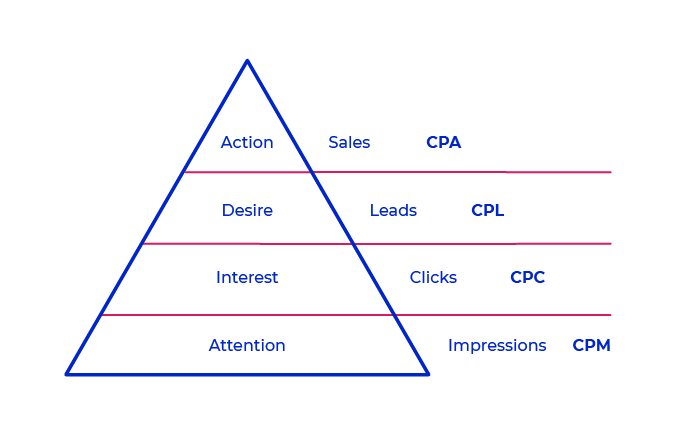Calculate Your Advertising Performance
Before we end this final section of the course, we will finish with a little tour of the different advertising pricing models, which will help you calculate the performance of your campaigns.
CPM (Cost Per Thousand)
If your key goal is to gain attention - perhaps for a company that is not yet known - the CPM model may work for you, as you're essentially paying for each opportunity for someone to see your ad. It's one of the most common pricing models for display advertising campaigns.
With a budget of $10,000 and an expected audience of 1,00,000 impressions, you will have a $10 CPM.
The calculation is: (10,000/1,00,000) x 1,000 = 10.
CPC (Cost Per Click)
If you're more focused on a specific reaction - say a click through to your website or Facebook page - you might choose this model. Each click's predefined cost determines the budget for the entire campaign, depending on the number of visitors desired. Google AdWords and other PPC (pay per click) vendors will charge you on this model for your campaign.
If you have determined a CPC of $1.20 and have 500 clicks from Google AdWords, this will cost $600 for the campaign.
CPL (Cost Per Lead)
This represents the total cost of the campaign divided by the number of leads acquired (new customer registrations, incoming requests). If the site's offer is convincing, then the company will get prospects, but at this stage, no sale. CPL tends to be used for long consideration purchases, especially in the business-to-business (B2B) sector.
If you have decided upon a budget of $15,000 and generated 150 leads, you get a cost per lead of $100.
CPA (Cost Per Action/Cost per Acquisition)
With CPA, you determine the cost of the campaign based on the number of times your ad converts a prospect into a customer; it’s a campaign focusing on performance. and represents the total amount of the marketing campaign divided by the number of customers who made a purchase.
You spent $1,000 on a campaign budget and generated 25 sales; your cost per acquisition is $40.
CTR (Click Rate)
This is the ratio between clicks and banner impressions. It allows you to compare which of your ads is generating the most reactions from your target audience.
If 1 in 100 people click on the banner, the CTR is 1%.
CVR (Conversion Rate)
This is the ratio between the completed action (a purchase or newsletter sign-up) and the number of visitors.
If one of 100 visitors to your site or landing page purchases your product, the CVR is 1%.
If you match the different advertising calculation models onto the AIDA model, you get the diagram below.

Let's Recap!
Now you can navigate your way around the buzzwords and acronyms that you'll hear when talking about digital ad campaigns. More importantly, you can calculate the effectiveness of the campaigns you launch. You can measure:
Cost per thousand.
Cost per click.
Cost per lead.
Cost per acquisition (or action).
Click through rate.
Conversion rate.
Congratulations, you are now at the end of this course. 👍 I hope that with all the skills you have acquired, you can start creating and implementing your advertising strategy.
Thank you for taking this course. I wish you success and hope that you create a great advertising strategy.😄
Remember to do the last assessment in order to validate your skills. One final push!
